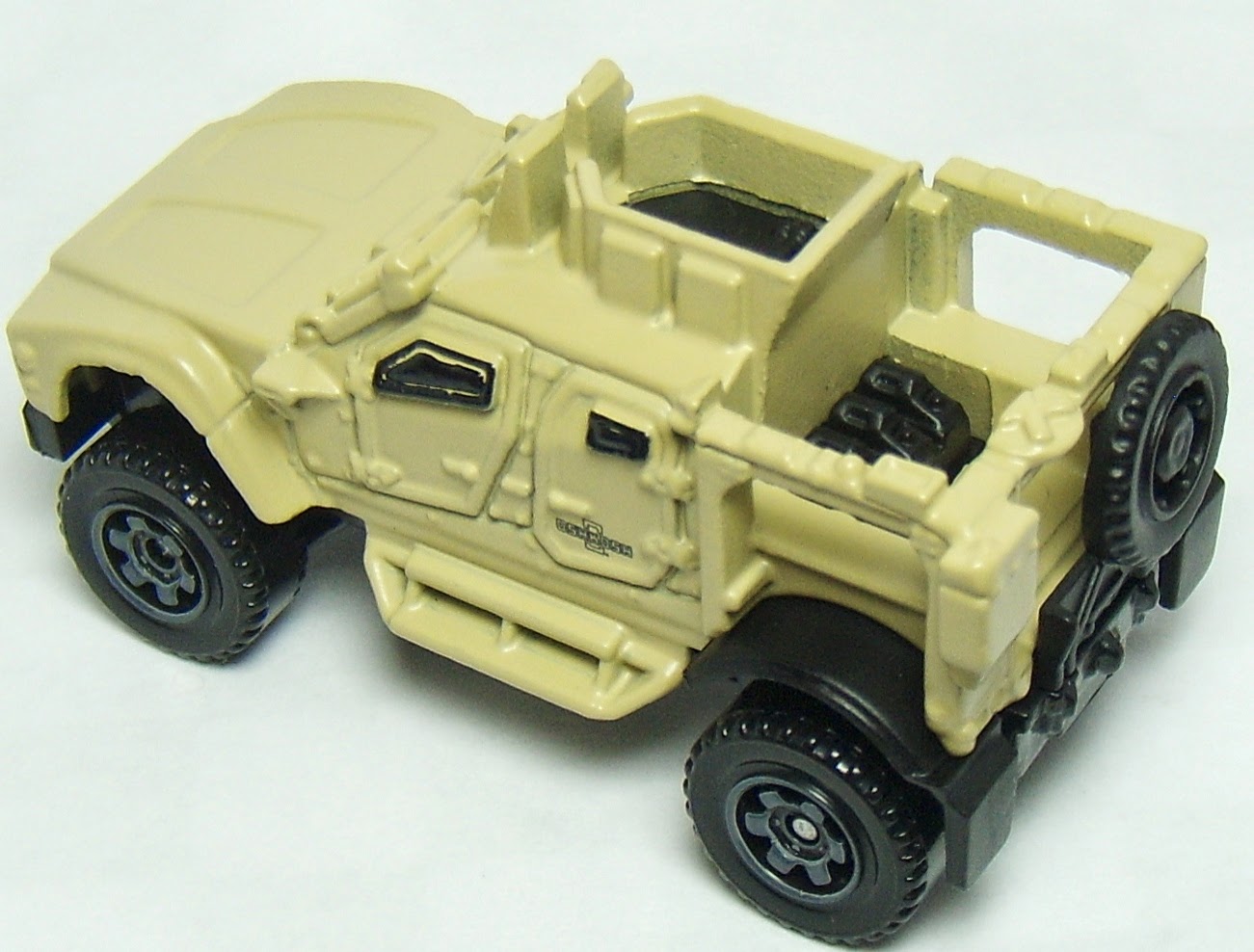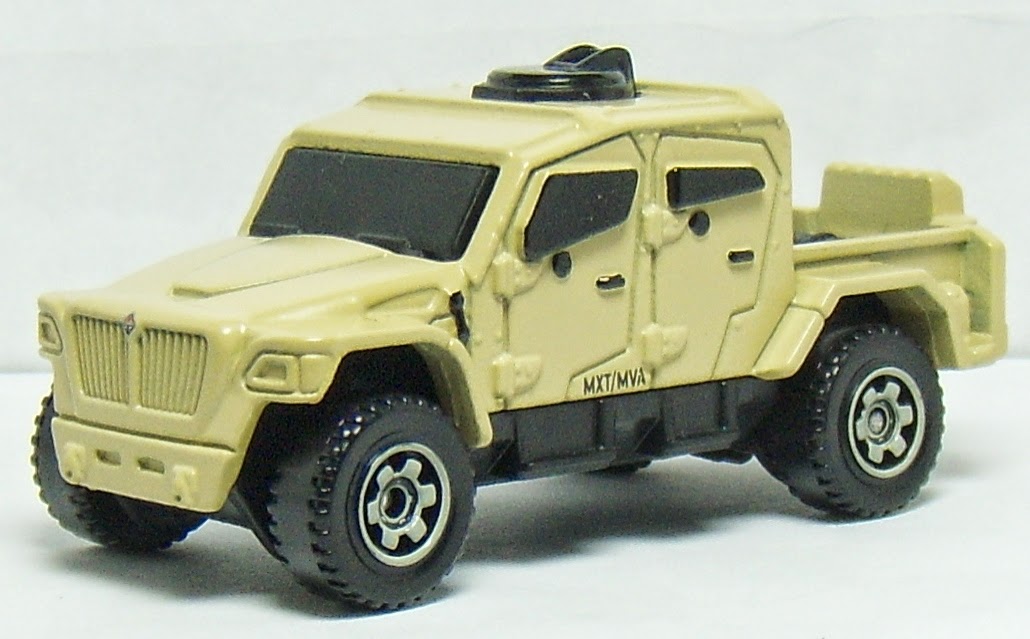The history of U.S. Military Personnel Vehicles by Matchbox
As much as we Americans praise our troops for their hard work and celebrate with replica's from Jeep's to G.I. Joe, the Military vehicles are not as often featured by diecast makers. Aside from Jeep and Hummer, the military versions come and go every so often, but thanks to Matchbox we now have a full history of the U.S. Military Personnel vehicles from the Jeep to the Oshkosh, and when I mean personnel I mean the vehicles used to transport troops and light materials around; the heavier stuff is reserved for the larger trucks and for heavy battle that would be for tanks. So let's take a look at the history.
Click Here for Photo Gallery
Jeep: Revolutionizing the military and civil life
After World War I, the U.S. military needed a better way to transport troops and gear to their destination that would be swift and safe from enemy fire than horse or a big, slow truck. So after the U.S. government sent out the contract to see who can develop a vehicle that can carry four troops, their gear, can go anywhere, and fit anywhere, Willys won the contract to build the so-called Jeep, a small four-wheel drive truck that was light, can carry four troops, and go anywhere it pleases without failure. Now the story about the creation of the Jeep is longer than I have the room to put on this blog, and there's been countless versions made by other manufacturers to support the amount of Jeep's needed during World War II, so be sure to check that out. The Willys-Jeep featured round headlights with the famous seven-slot grille, exposed latches for hood, fold-down windshield, top, and mounting places for axe, shovel, shotgun, and in the rear for the gas can and spare tire, all painted in olive green.
Click Here for Photo Gallery
Inside it's spare bones with bucket seats in the front, bench seat in rear, and simple dash with central gauges, 3-spoke wheel, and two shift levers for transmission and transfer case. Some models were converted for special occasions, like the Ambulance with the deletion of passenger and rear seat to place a gurney for wounded solder's. The power comes from the 2.2L Go Devil I-4 producing 60 hp. and 105 Ib-ft. torque through a three-speed manual and a two-speed transfer case to front and rear live axles. The Jeep was successful for its ability to go anywhere, forge hills and streams, and carry all troops safely to their destination, while being light enough to be carried by two people! Matchbox has made the Jeep in several variations, but this 2009 version is the most accurate and best. It was a surprise for me to find it as the first new casting for 2010 and I must say it looks great and lots of fun. One interesting touch is a moveable suspension that allows articulation but firm enough to keep the Jeep stable without the body roll found in previous Matchbox suspension systems.
Click Here for Photo Gallery
Humvee: The Next Stage
In the 1970's it was apparent the Jeep was not as secure or durable to carry even heavier equipment, so a new larger Jeep replacement was created, this time under AM General name. The only thing the HMMWV (hence 'Humvee') shared was the seven-slot grille. The new Humvee is larger, wider, with a hood-mounted radiator with hooks for air-lift, larger, sealed cabin with four doors (some with open roof), hood-mounted air vent for engine to forge deep streams, an access door on the roof to access the roof-mounted gun, on some models a fastback rear with opening trunk and fold-down tailgate. The interior seats four, but is less roomy since the engine and drivetrain is placed high in the chassis to protect the chassis from roadside bombs, oh and it's Spartan and all the switches and controls are placed toward the driver. Then again, the center allows for storage of gear and a stand for the roof-top gunner. The engine is now a 6.2L Diesel V8 producing 190 hp. and 380 Ib-ft. torque through a three-speed automatic; much needed since the Humvee is bigger and much heavier thanks to the new body armor. The two-speed transfer case delivers power to the central-placed front and rear differentials with integrated disc brakes (instead of behind the wheels), to a four wheel independent suspension and out to tires that feature a central tire inflation system on all four wheels. Approach and Departure angles are steeper, allowing a climb up hills.
Click Here for Photo Gallery
The Humvee was unbeatable in the Gulf War, and after the war, just like the Jeep, gained civilian honors and clothes for personal use. Matchbox released this casting in 1994 to celebrate the honor with an opening rear trunk and integrated roof gun (not shown) and working suspension, but no interior. In 2001 the casting was modified without the roof gun and featured a civilian look and new wheels; this was introduced in replacement for the Hummer H2 SUV concept that was delayed until 2003. Since then the Hummer gained more powerful diesel motor from General Motors, along with the adoption of the more civilian H2 based on the Chevy Tahoe platform. Sadly the armor wasn't standing up to the demands of the Iraq war, and even after adding stronger armor it wasn't enough, plus it was taxing the suspension and speed of the Humvee. So a new military vehicle was in order.
Click Here for Photo Gallery
Oshkosh M-ATV: Bigger and Brawnier
Oshkosh corporation, the Wisconsin-based truck manufacturer of snow-plows and larger military vehicles, introduced the smaller M-ATV to replace the Humvee, but it's not small: It's as big as a 10-wheel highway dump truck, yet still manage to fit in an aircraft carrier! The larger M-ATV features a forward-leaning front with twin grille slots (thanks to Jeep, no one can use the seven-slot grille anymore), headlights and turn signals inside coves to give the aggressive look, and the bumper with hooks integrated. The hood has a long rake back to the smaller split windshield and smaller, but thick side windows for armor, joined by roof-mounted intake snorkel and lights. The side doors are smaller and the rear doors open backward, while steps allow easy access to the interior, while the front has aggressive fender curves and the rear has fenders that look like add-on's. The roof gunner position now has a taller shield to protect the gunner, the gas tanks are inside the open cargo area with frame mount that can be covered with a top and contains a spare tire rather highly-mounted. The rear looks like a typical big rig look with fender flaps and three taillights. Again, just like the Humvee the Matchbox version lacks an interior but from what I've seen the interior is much more roomy with seating for five and a dash layout similar to today's passenger trucks.
Click Here for Photo Gallery
The power comes from 7.2L Turbodiesel Caterpillar I-6 producing 370 hp. and 925 Ib-ft. torque through a 6-speed automatic with manumatic shifting, through the same two-speed transfer case, center differential's as the Humvee, but with some slight differences. The biggest is larger ground clearance and better chassis protection, and should the damage be severe enough the cabin is specially designed to protect occupants. The first release of this Matchbox version in 2012 was not so special, but this 2014 release is the best in tan color with headlight and grille details and Oshkosh logo on the rear doors.
Click Here for Photo Gallery
International MXT-MVA: the second option
Though not as widely used, the International MXT-MVA gives a second option over the Oshkosh for troops to ride in. Based on the big MXT, itself based on the International Durastar series, the MVA is actually a different version being lower and smaller and specifically designed for military use even though it was initially designed for civilian use at first as a competitor to one-ton light-duty pickups. The MVA features the International grille in the front with larger headlights and bumper-less look for better approach angles. The windshield offers a better view than the M-ATV, but features the smaller thicker side windows and doors for protection with steps to get into the interior. The roof also has a gunner access with a shield to protect the gunner, while the rear features larger tri-taillights, no bumper, and a shelf to hold six gas cans. This leaves the bed open to carry almost anything. Again, no interior, but just like the M-ATV it features a more roomier interior with seating for five and a dash similar to the International MXT.
Click Here for Photo Gallery
The power comes from the 6.4L Turbodiesel V8 producing 350 hp. and 650 Ib-ft. torque through a six-speed automatic and through a two-speed transfer case to differentials different from the M-ATV. Even though the suspension is setup different from the M-ATV, it features the same ground clearance and protection. This Matchbox version introduced in 2013 has been doing a superb job keeping the profile clean from wild graphics, the best is this 2013 version in tan that perfectly matches the 2014 M-ATV version.
Click Here for Photo Gallery



















Comments
Post a Comment